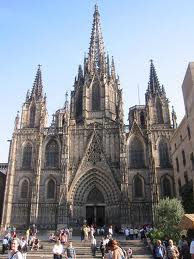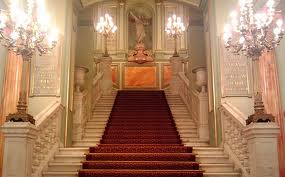Historicist Architecture
Historicism is one of the most curious artistic tendencies found in the history of architecture. Sometimes dubbed Eclecticism, it consists in the copy of the aesthetics - of the final result - of a given period of time, or often, of several periods simultaneously. The results are extremely variable, depending on the style copied and the fidelity with which it is copied. Thus, you could end up with anything from a pastiche to a building that could genuinely fool the viewer.
Barcelona Cathedral

A point in case, for instance, is Barcelona Cathedral. Built towards the end of the XIII century in the typical Levantine Gothic style, the building used to have the plain and subdued facade that characterises such style. And yet, if you have been to language schools in Barcelona, you know this description does not fit the city's cathedral.
That is because Barcelona Cathedral drastically changed the way it looked sometime in the middle of the XIX century, largely thanks to the efforts of Josep Oriol Mestres, whose plans for the new facade included the erection of two belfries topped with pinnacles and enhancements of the section off the gate with several archivolts and their corresponding jambs hosting images of saints.
Additionally, a tall spire, designed by August Font i Carreras, was fitted right on the cross section of Barcelona Cathedral, which gives the whole a much more majestic feeling, propelled by a Neogothic style that took as point of reference the precepts of French Gothic, rather than the more austere aesthetics of the Levantine style.
Other Buildings
Similar expressions of Historicism are found in the architecture of Catalonia, such as the 'Gran Teatro del Liceo', known in Catalan as El Liceu, also designed and built by Oriol Mestres. Or the church of Vilafranca de Penedés, also fitted with a Neo-Gothic facade, the work of Font i Carreras who has inscribed the main entrance in six archivolts and designed an elaborate architectural pattern on each side of the doorway, adorning it with pinnacles and images.
However, not all buildings corresponding to Historicism were built in Barcelona or its surroundings. As a matter of fact, if Barcelona Cathedral has a Neo-Gothic facade, the cathedral of La Almudena in Madrid was conceived as a Neo-Gothic and Neo-Romanesque church. Designed originally by the Marquis of Cubas, the crypt is the only remaining part of the original plan, as the church itself was later turned into a Neoclassical building, one hundred years after its time.

A fairer look into the neo- capabilities of the Marquis of Cubas is provided by the work he carried out in the Basque country, both in relation to the University of Duesto, a large building in Neo-Romanesque and Neoclassicist style, and, especially, the castle of Butron in Gatica, a highly romanticised reconstruction of a Medieval castle which is inspired more in playful fantasy than on any other architectural style.
Not quite as prevalent in Spain as the Neo-Gothic style, Neo-Romanesque also found a place in the landscape of the country in the XIXX century. A particularly good example of the proposal put forward by this genre is the Basilica of Santa Maria la Real in Covadonga.
Built from 1877 after the design of Roberto Frassinelli, the church bears monumental dimensions that stand out thanks partly to the pink marble used in its construction. Relatively faithful in its conception, the building features small semicircular windows and hexafoil rose windows as well as two tall belfries crowned with high spires and four pinnacles each.
Finally, towards the end of the XIX century a new tendency emerged in spanish architecture, which embraced a typically local style such as Mudéjar and adapted it to the neo- fashion. Propelled by Emilio Rodriguez Ayuso and his erection of the Goya Bullring in Madrid, Neo-Mudéjar style quickly became a popular choice.
The best surviving example of Rodriguez Ayuso's Neo-Mudéjar aesthetic is the former Escuelas Aguirre, now used as the Casa Árabe in Madrid, which takes full advantage of bricks as a decorative and simultaneously a structural element. The building feature a tall tower sumptuously decorated with techniques taken from traditional Mozarabic origins.
